-
This community needs YOUR help today. We rely 100% on Supporting Memberships to fund our efforts. With the ever increasing fees of everything, we need help. We need more Supporting Members, today. Please invest back into this community. I will ship a few decals too in addition to all the account perks you get.

Sign up here: https://www.muzzleloadingforum.com/account/upgrades -
Friends, our 2nd Amendment rights are always under attack and the NRA has been a constant for decades in helping fight that fight.
We have partnered with the NRA to offer you a discount on membership and Muzzleloading Forum gets a small percentage too of each membership, so you are supporting both the NRA and us.
Use this link to sign up please; https://membership.nra.org/recruiters/join/XR045103
You are using an out of date browser. It may not display this or other websites correctly.
You should upgrade or use an alternative browser.
You should upgrade or use an alternative browser.
Rifle Stock Stain
- Thread starter btech
- Start date

Help Support Muzzleloading Forum:
This site may earn a commission from merchant affiliate
links, including eBay, Amazon, and others.
You must have some VERY hard maple.
No, it won't accept oil based stains but very few hardwoods will.
Yes, it is easy to stain with a alcohol based stain (assuming you have not already applied a oil based stain).
These maple stocks were all stained with alcohol based stains and they look pretty good to me. :grin:
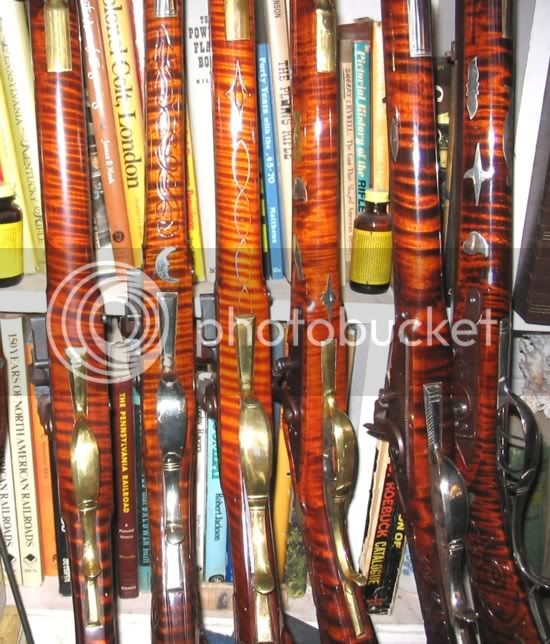
No, it won't accept oil based stains but very few hardwoods will.
Yes, it is easy to stain with a alcohol based stain (assuming you have not already applied a oil based stain).
These maple stocks were all stained with alcohol based stains and they look pretty good to me. :grin:

don hepler
58 Cal.
- Joined
- Nov 19, 2010
- Messages
- 2,260
- Reaction score
- 10
I don't understand. If you want it light, and it won't accept stain, then it will be light. The hard part, with maple, is to get it dark. That's why Aqua Fortis, and acids are used to get the wood to take the stain. The dark colors, make the strips in the maple, pop out. The stripe is harder, than the less dense wood between the stripes. Unless, the wood you have is plain. I've seen stocks with little or no stain, and they're about the color of an ash baseball bat. It would help, to see a picture.
don hepler
58 Cal.
- Joined
- Nov 19, 2010
- Messages
- 2,260
- Reaction score
- 10
You posted, while I was typing. Man, that's some beautiful wood.
galamb
58 Cal.
Zonie said:These maple stocks were all stained with alcohol based stains and they look pretty good to me. :grin:
Disagree, those look "hideous" - I'll send you my address and you can mail them to me, relieving you of those horrible examples :rotf:
Seriously, that's some very nice finishes there.
Recently I have noticed quite a few water based stains on the market as well with hundreds of color options if you blend the 30 or so "base" colors.
Just have to experiment a bit with scrap wood until you find what suits your taste. When I'm working with tiger maple and really want the stripes to stand out I use a black water based stain (a couple of coats) and then really knock it back with some (plastic) 0000 steel wool. It takes the black off the "harder" part of the maple, highlighting the softer wood and then go with the color I want over that.
Multiple coats of true-oil over that and it sure looks sweet.
I got a precut stock and it didn't have much curl. Very straight grain. So there isn't much configuration to bring out. I also used a stain that had a sealant. I think that was a mistake. You can't control the depth of color with subsequent coats. I'm still learning.
blackdog of vt
40 Cal.
- Joined
- Nov 15, 2012
- Messages
- 213
- Reaction score
- 3
There is plenty of original rifles that aren't dark. It also depends on the color you want. If you want to go light as is the lion Beck or Schreit, lye will give it a nice golden color. Ferric nitrate crystals are easy to control and can give any shade from red to brown.
Nah. You wouldn't want any of those rifles.
They all have straight octagon barrels on them.
(Except for the second from the top)
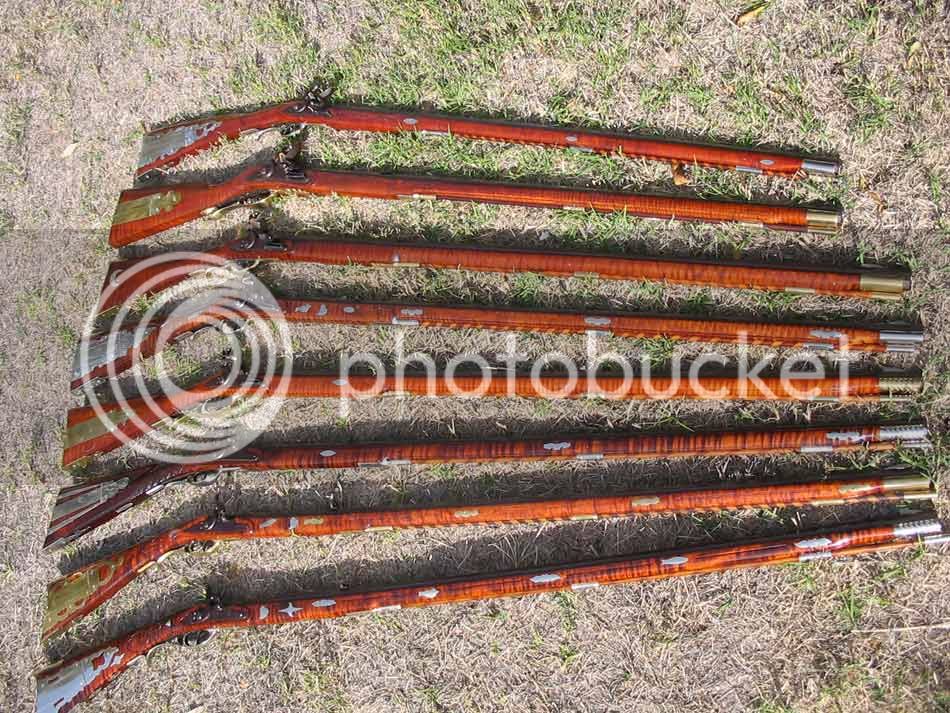
The only darkening agent used on any of these was a wash of lye water which brings out the tannin in the wood.
I see folks talking about the hard and soft areas of curly wood.
That is kinda right but it doesn't tell the whole story of why these woods have stripes.
Curly wood like curly maple doesn't have straight grain like normal wood does.
The grain is wavy like the lines in this sketch:
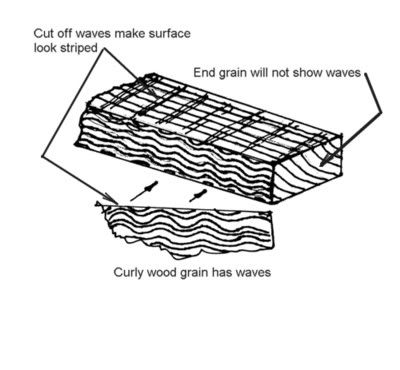
Where the waves meet the surface, they are cut off leaving essentially the end grain showing.
End grain will release more tannin with the lye water treatment than the grain in the areas where it is running parallel to the surface.
It also absorbs more of the stain/aquafortis than the parallel fibers so it ends up darker.
They all have straight octagon barrels on them.
(Except for the second from the top)

The only darkening agent used on any of these was a wash of lye water which brings out the tannin in the wood.
I see folks talking about the hard and soft areas of curly wood.
That is kinda right but it doesn't tell the whole story of why these woods have stripes.
Curly wood like curly maple doesn't have straight grain like normal wood does.
The grain is wavy like the lines in this sketch:

Where the waves meet the surface, they are cut off leaving essentially the end grain showing.
End grain will release more tannin with the lye water treatment than the grain in the areas where it is running parallel to the surface.
It also absorbs more of the stain/aquafortis than the parallel fibers so it ends up darker.
And when you cut the at 45 degrees across the grain you get 'quarter-sawn', usually in oak and chestnut and for furniture though.
Though at the moment I'm visually-impaired! Those rifles took my breath and sight away! Wow!! Think I need to go lay down now!!
Though at the moment I'm visually-impaired! Those rifles took my breath and sight away! Wow!! Think I need to go lay down now!!
galamb
58 Cal.
Ok Zonie, you have given up a bit of the "secret" with the lye wash. How 'bout posting up your whole method.
I can't get Aqua Fortis (commercially packaged) due to import regs etc, and have no desire to start mixing chemicals/acids etc that can either go boom or poison me in the shop, so I stick to oil or water based stains or water based dyes.
Whether I'm going for a dark or light finish I start with two coats of water based black stain and then knock it back with 0000 steel wool.
Over top of that I have used mahogany or walnut stain (oil based) for my dark finishes or very light cherry stains to get that more reddish look.
I have also mixed RIT dyes in water to get a specific color I'm looking for, but find them iffy at best, and the color tends to sit too close to the surface for my liking.
My finish is almost always Tru-Oil - some love it, some hate it, I find it more durable than linseed or tung oil you find at the lumber yards, the quality of which can vary widely unless you find a decent source and buy alot from the same batch.
So come on now, cough up your "finishing secrets" :grin:
I can't get Aqua Fortis (commercially packaged) due to import regs etc, and have no desire to start mixing chemicals/acids etc that can either go boom or poison me in the shop, so I stick to oil or water based stains or water based dyes.
Whether I'm going for a dark or light finish I start with two coats of water based black stain and then knock it back with 0000 steel wool.
Over top of that I have used mahogany or walnut stain (oil based) for my dark finishes or very light cherry stains to get that more reddish look.
I have also mixed RIT dyes in water to get a specific color I'm looking for, but find them iffy at best, and the color tends to sit too close to the surface for my liking.
My finish is almost always Tru-Oil - some love it, some hate it, I find it more durable than linseed or tung oil you find at the lumber yards, the quality of which can vary widely unless you find a decent source and buy alot from the same batch.
So come on now, cough up your "finishing secrets" :grin:
If you can get Alcohol based stains, you will find there is a a whole dif. world in gun finishing. My preference is Danglers stains. They work wonderfully, easy to apply, really easy to blend, easy to rub back out, just wonderful stain.
Also, bear in mind the beauty & stripes in the wood are Already there, the stain doesn't make it, it just enhances it. So many times a guy buys a $100. precarved stock & want to stain it to show like a $400. stock....... It's not gonna happen. That being said, the lye wash will help bring the tannin out & make the stripes pop, IF... the stripes are there...
Keith Lisle
Also, bear in mind the beauty & stripes in the wood are Already there, the stain doesn't make it, it just enhances it. So many times a guy buys a $100. precarved stock & want to stain it to show like a $400. stock....... It's not gonna happen. That being said, the lye wash will help bring the tannin out & make the stripes pop, IF... the stripes are there...
Keith Lisle
Black Hand
Cannon
- Joined
- Mar 17, 2005
- Messages
- 9,348
- Reaction score
- 893
Stain/sealer combos might be great for furniture projects, but not gun-building.btech said:I also used a stain that had a sealant. I think that was a mistake. You can't control the depth of color with subsequent coats.
Try Aquafortis reagent, you won't be disappointed.
galamb
58 Cal.
Thanks Keith for the suggestion on the alcohol stains. I will have to do some looking.
I build my own stocks from "boards" (don't even get cut blanks), so do get some fine tiger maple (curly Red maple - prefer the soft maple).
In the past number of years, in Canada, we can't get "liquid" imported from your side of the border and our domestic market is far too small for more specialized products to be carried.
On a positive note, I will be stopping in at Dixon's in PA in a couple of weeks and have a long shopping list - just need to figure out what I need to put on it in the first place, especially as far as stains/finishes is concerned.
I build my own stocks from "boards" (don't even get cut blanks), so do get some fine tiger maple (curly Red maple - prefer the soft maple).
In the past number of years, in Canada, we can't get "liquid" imported from your side of the border and our domestic market is far too small for more specialized products to be carried.
On a positive note, I will be stopping in at Dixon's in PA in a couple of weeks and have a long shopping list - just need to figure out what I need to put on it in the first place, especially as far as stains/finishes is concerned.
If you can't get aqua fortis, order Ferric Nitrate crystals and mix with denatured alcohol. Very simple, couldn't be easier. The Science Company's website say they ship UPS ground to Canada. http://www.sciencecompany.com/Ferric-Nitrate-100g-P6384.aspx
Just mix, brush on, wait for it to dry thoroughly (very important IMO), and blush with a heat gun. Here are a couple of photos of my first attempts using it on my maple stocked fowler:
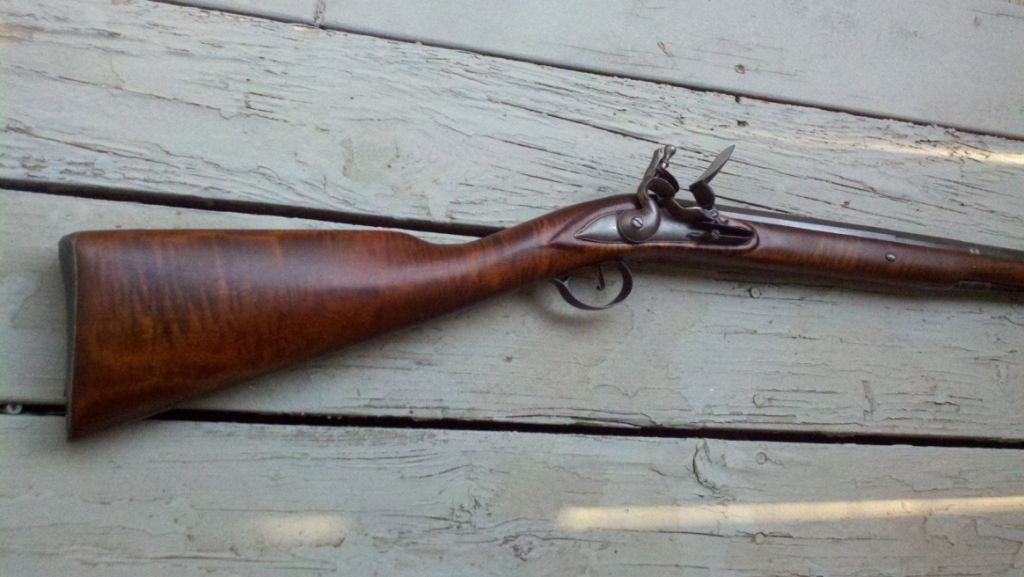
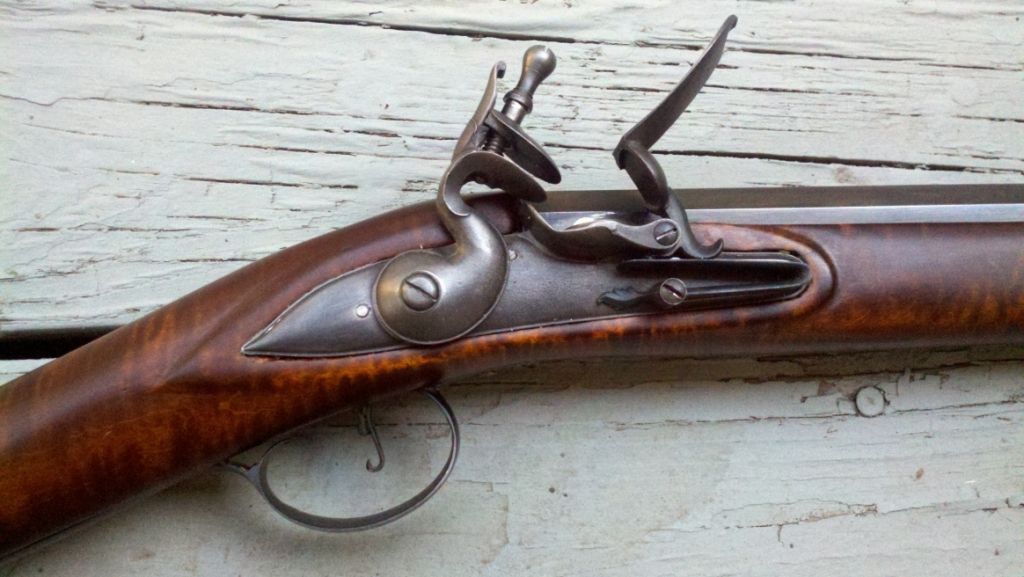
The nice thing about using the crystals/denatured alcohol mix is that you can mix up just as much as you need as you go along.
Just mix, brush on, wait for it to dry thoroughly (very important IMO), and blush with a heat gun. Here are a couple of photos of my first attempts using it on my maple stocked fowler:


The nice thing about using the crystals/denatured alcohol mix is that you can mix up just as much as you need as you go along.
Last edited by a moderator:
galamb
58 Cal.
Just so I'm totally clear on it, you have nothing else on the stock there as pictured (as far as any other stain etc).
If so, the result is impressive.
If so, the result is impressive.
Yup, no stain, nothing but ferric nitrate crystal/denatured alcohol mix and then blushing with a heat gun. I was amazed also. It was a grade 2 maple stock from Pecatonica River, i.e., about 50% curl.
The ferric nitrate crystals dissolve pretty well in the denatured alcohol. You get a yellow-reddish solution that you brush on the stock liberally. Let the stock dry very thoroughly before blushing with the heat gun. Some of the other forum members have used this solution to good effect also... IIRC MeteorMan has posted some pics of a Tennessee rifle stock using it.
IIRC, I did a second brush-on, blush cycle with the solution on this stock, although in hind sight I don't think it was absolutely necessary.
I wore rubber gloves and did it outside, however, I didn't notice any fumes, etc. It all was very tame and easy. I actually found it easier than stain. Also, since you can mix up small quantities as you go, you can avoid having to deal with the large quantities of leftover solution.
The ferric nitrate crystals dissolve pretty well in the denatured alcohol. You get a yellow-reddish solution that you brush on the stock liberally. Let the stock dry very thoroughly before blushing with the heat gun. Some of the other forum members have used this solution to good effect also... IIRC MeteorMan has posted some pics of a Tennessee rifle stock using it.
IIRC, I did a second brush-on, blush cycle with the solution on this stock, although in hind sight I don't think it was absolutely necessary.
I wore rubber gloves and did it outside, however, I didn't notice any fumes, etc. It all was very tame and easy. I actually found it easier than stain. Also, since you can mix up small quantities as you go, you can avoid having to deal with the large quantities of leftover solution.
Similar threads
- Replies
- 16
- Views
- 691
- Replies
- 3
- Views
- 182
- Replies
- 14
- Views
- 780



